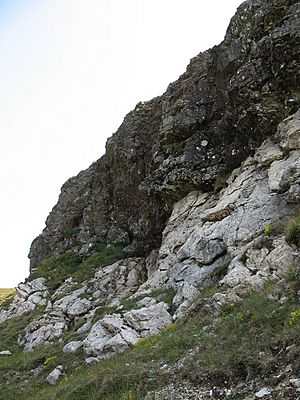Durness Group facts for kids
Quick facts for kids Durness GroupStratigraphic range: Cambrian–Ordovician |
|
|---|---|

Dolomites of the Durness Group with schists of the Moine Supergroup thrust over them on the Moine Thrust at Knockan Crag
|
|
| Type | Group |
| Sub-units | Ghrudaidh Formation, Eilean Dubh Formation, Sailmhor Formation, Sangomore Formation, Balnakiel Formation, Croisaphuill Formation, Durine Formation |
| Underlies | Moine Supergroup along the Moine Thrust. |
| Overlies | An t-Sron Formation of the Ardvreck Group |
| Thickness | up to 750 m (2,460 ft) |
| Lithology | |
| Primary | Dolomite |
| Other | Limestone, chert |
| Location | |
| Region | Northwest Highlands |
| Country | |
| Type section | |
| Named for | Durness |
The Durness Group is a collection of rock layers found in the Northwest Highlands of Scotland. These rocks are mostly made of a type of rock called dolomite. They formed a very long time ago, between the late Cambrian and early Ordovician periods. That's about 485 to 500 million years ago!
You can find the Durness Group rocks all along a special geological feature called the Moine Thrust Belt. Sometimes, these rocks have been pushed and broken by huge forces in the Earth, creating what geologists call thrust faults.
Contents
What is the Durness Group?
The Durness Group is a "geological group." This means it's a set of rock layers that share similar features. Think of it like different chapters in a very old book about Earth's history. These layers were laid down one after another over millions of years.
What Rocks Make Up the Durness Group?
The main rock you'll find in the Durness Group is dolomite. Dolomite is a rock that looks a bit like limestone. It forms in shallow seas from the shells and skeletons of tiny sea creatures. You might also find some Limestone and chert mixed in. Chert is a very hard rock, often found as small lumps.
How Thick Are These Rock Layers?
The Durness Group can be quite thick! In some places, these rock layers stack up to about 750 meters (or 2,460 feet) deep. That's taller than many skyscrapers!
Where Can You Find the Durness Group?
The Durness Group is located in the Northwest Highlands of Scotland. It stretches across a long area known as the Moine Thrust Belt. This area is famous for its amazing geology, where older rocks have been pushed over younger ones.
Why is the Moine Thrust Belt Important?
The Moine Thrust Belt is a special place for geologists. It's where massive pieces of the Earth's crust slid over each other. This movement caused the Durness Group rocks to be affected by thrust faulting. This means the rocks were broken and pushed around, creating interesting patterns.
What Are the Different Parts of the Durness Group?
The Durness Group is actually made up of several smaller rock units, like different sections within a big book. These are called "formations." Each formation has its own unique features. Some of these formations include:
- Ghrudaidh Formation
- Eilean Dubh Formation
- Sailmhor Formation
- Sangomore Formation
- Balnakiel Formation
- Croisaphuill Formation
- Durine Formation
These formations help geologists understand the different environments that existed when these rocks were forming millions of years ago.

